Java 代碼檢查工具之PMD入門(mén)使用詳細(xì)教程
PMD是一個(gè)靜態(tài)源代碼分析器。它發(fā)現(xiàn)了常見(jiàn)的編程缺陷,如未使用的變量、空捕獲塊、不必要的對(duì)象創(chuàng)建等等。
官網(wǎng):點(diǎn)這里官方文檔:點(diǎn)這里
使用方式1、使用插件的方式下載:File -> Settings -> Plugins -> Marketplace 搜索 “PMDPlugin” ,下載插件。
使用方法:在代碼編輯框或Project 窗口的文件夾、包、文件右鍵,選擇“Run PMD”->“Pre Defined”->“All”,對(duì)指定的文件夾、包、文件進(jìn)行分析,分析結(jié)果在控制臺(tái)輸出。
2、maven項(xiàng)目引入依賴(lài)的方式pom.xml:
<?xml version='1.0' encoding='UTF-8'?><project xmlns='http://maven.apache.org/POM/4.0.0' xmlns:xsi='http://www.w3.org/2001/XMLSchema-instance' xsi:schemaLocation='http://maven.apache.org/POM/4.0.0 http://maven.apache.org/xsd/maven-4.0.0.xsd'> <modelVersion>4.0.0</modelVersion> <groupId>com.keafmd</groupId> <artifactId>pdm-test01</artifactId> <version>1.0-SNAPSHOT</version> <!--<dependencies> <dependency> <groupId>org.apache.maven.plugins</groupId> <artifactId>maven-pmd-plugin</artifactId> <version>3.14.0</version> <type>maven-plugin</type> </dependency> </dependencies>--> <!-- 用于生成錯(cuò)誤到代碼內(nèi)容的鏈接 --> <reporting> <plugins> <plugin> <groupId>org.apache.maven.plugins</groupId> <artifactId>maven-pmd-plugin</artifactId> <version>3.14.0</version> </plugin> </plugins> </reporting></project>
mvn 命令執(zhí)行
在項(xiàng)目目錄打開(kāi)cmd窗口,輸入以下命令:
mvn pmd:pmd
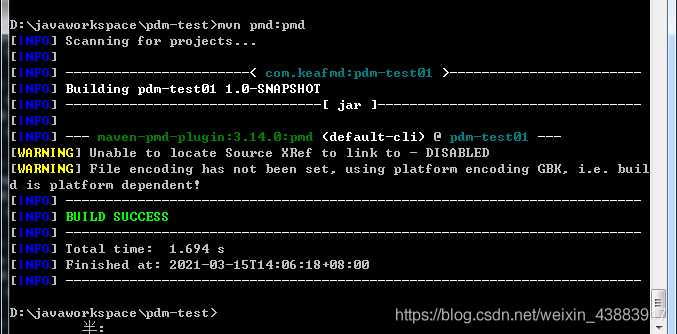
分析結(jié)果為pmd.html文件,在項(xiàng)目的target下的site目錄下:
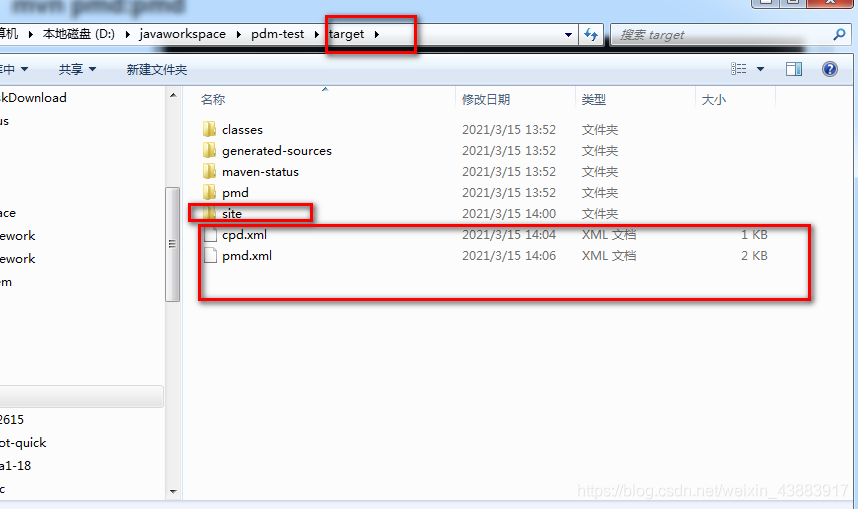
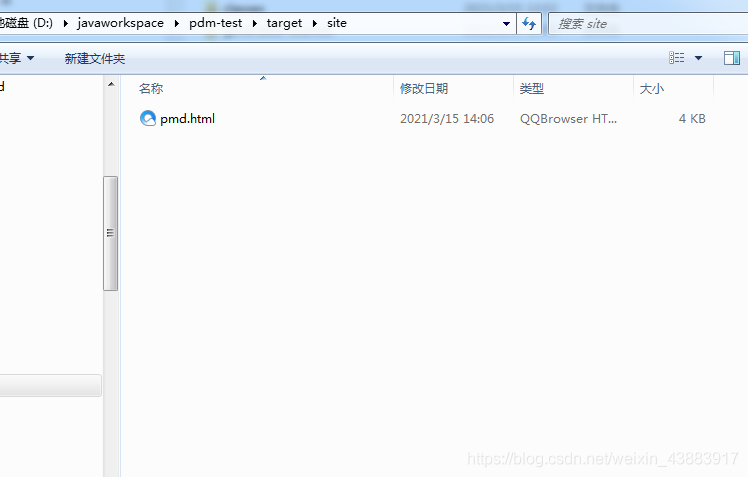
分析結(jié)果顯示內(nèi)容:

pmd -d 源代碼路徑 -f xml(結(jié)果輸出格式) -r 結(jié)果保存所在目錄及名稱(chēng) -R rulesets/java/unusedcode.xml
例子:
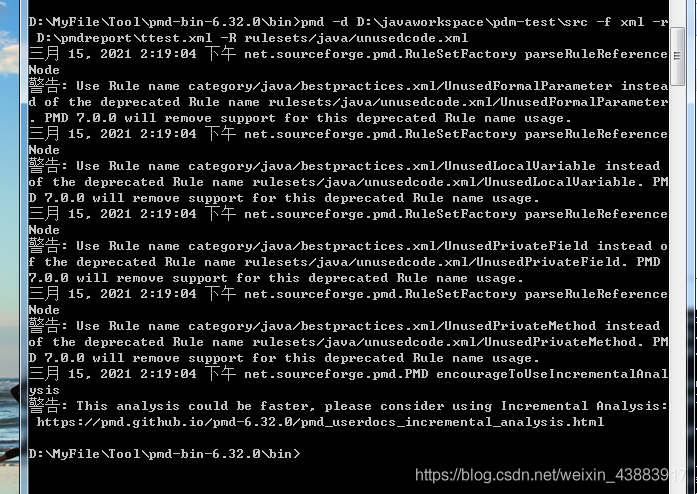
結(jié)果存放在制定文件目錄下,格式也為命令語(yǔ)句指定的:
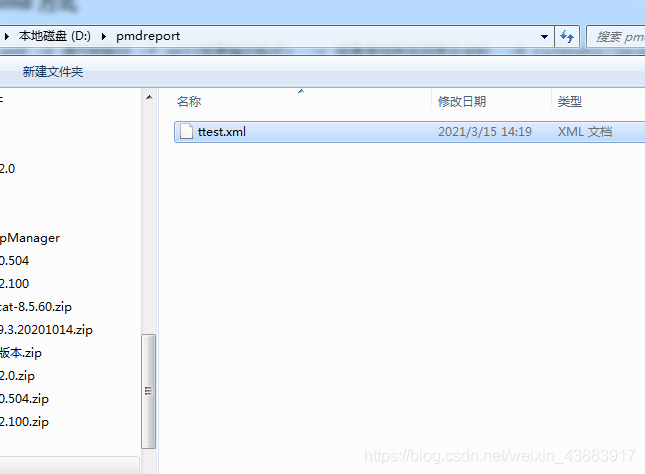
檢測(cè)結(jié)果內(nèi)容:
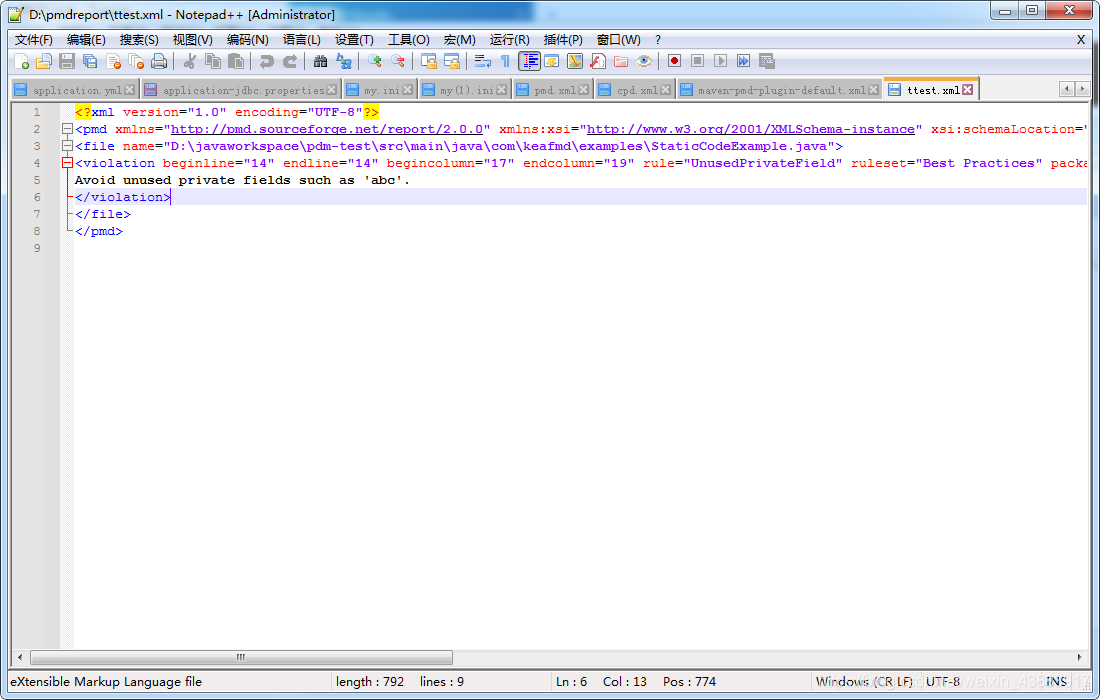
官方文檔
需要先引入maven依賴(lài)
項(xiàng)目結(jié)構(gòu)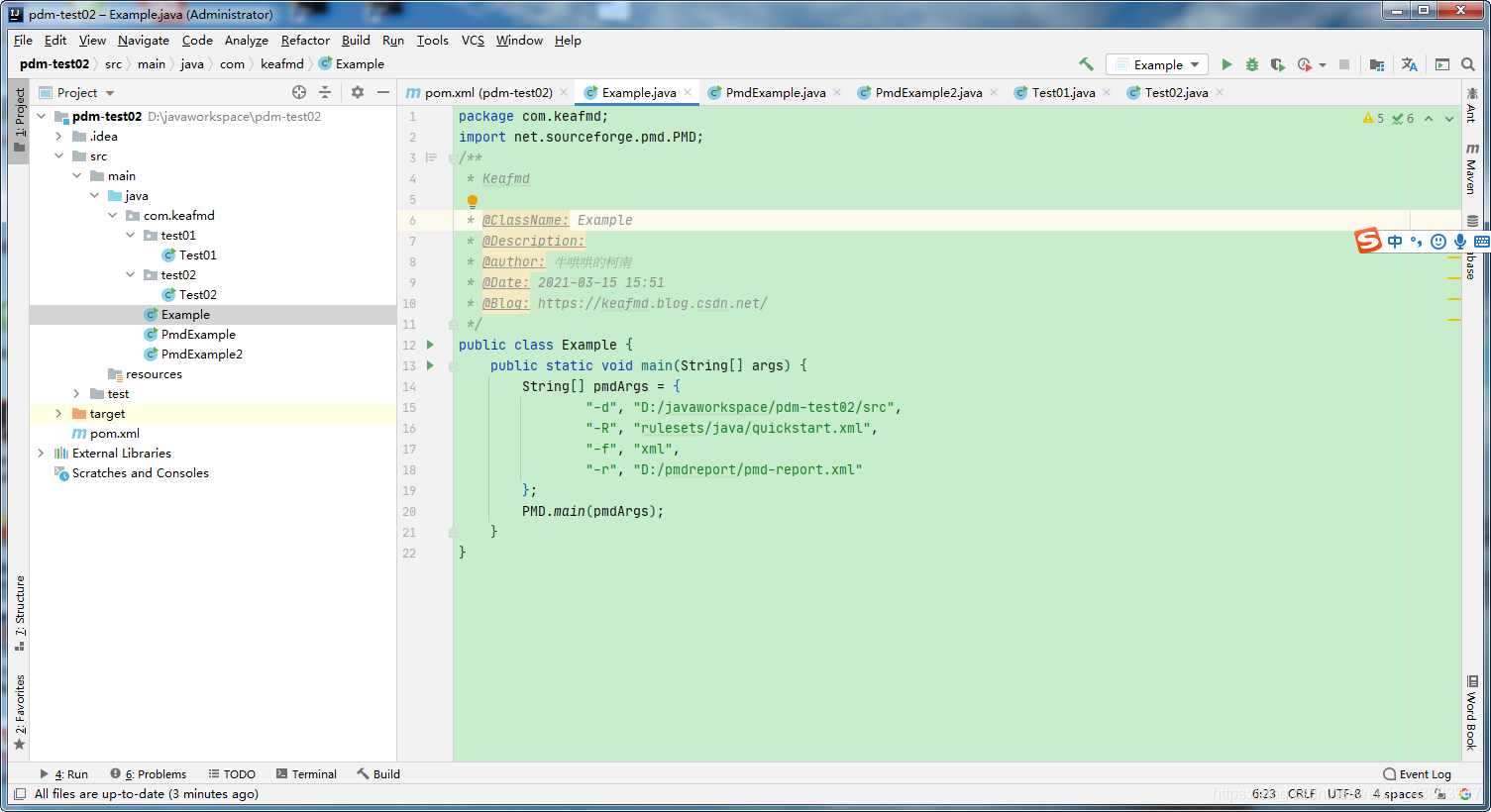
Test01:
package com.keafmd.test01;/** * Keafmd * * @ClassName: Test01 * @Description: 測(cè)試1 * @author: 牛哄哄的柯南 * @Date: 2021-03-15 15:29 * @Blog: https://keafmd.blog.csdn.net/ */public class Test01 { public static void main(String[] args) { int a =100; int b=29; String s ='abc'; System.out.println('hello!'); }}
Test02:
package com.keafmd.test02;/** * Keafmd * * @ClassName: Test02 * @Description: * @author: 牛哄哄的柯南 * @Date: 2021-03-15 15:30 * @Blog: https://keafmd.blog.csdn.net/ */public class Test02 { public static void main(String[] args) { boolean flag=true; while(flag){ flag=false; } System.out.println('123'); int a =100; int b=29; String s ='abc'; System.out.println('hello!'); }}pmdArgs方式
命令行接口的方式最簡(jiǎn)單的方法是使用與命令行相同的接口調(diào)用PMD
Example :
package com.keafmd;import net.sourceforge.pmd.PMD;/** * Keafmd * * @ClassName: Example * @Description: * @author: 牛哄哄的柯南 * @Date: 2021-03-15 15:51 * @Blog: https://keafmd.blog.csdn.net/ */public class Example { public static void main(String[] args) { String[] pmdArgs = { '-d', 'D:/javaworkspace/pdm-test02/src', '-R', 'rulesets/java/quickstart.xml', '-f', 'xml', '-r', 'D:/pmdreport/pmd-report.xml' }; PMD.main(pmdArgs); }}PMDConfiguration方式
PmdExample:
package com.keafmd;import net.sourceforge.pmd.PMD;import net.sourceforge.pmd.PMDConfiguration;/** * Keafmd * * @ClassName: PmdExample * @Description: * @author: 牛哄哄的柯南 * @Date: 2021-03-15 15:57 * @Blog: https://keafmd.blog.csdn.net/ */public class PmdExample { public static void main(String[] args) { PMDConfiguration configuration = new PMDConfiguration(); configuration.setInputPaths('D:/javaworkspace/pdm-test/src'); configuration.setRuleSets('rulesets/java/quickstart.xml'); configuration.setReportFormat('html'); configuration.setReportFile('D:/pmdreport/pmd-report.html'); PMD.doPMD(configuration); }}Programmatically(拓展)
這使您能夠更好地控制處理哪些文件,但也會(huì)更加復(fù)雜。您還可以提供自己的偵聽(tīng)器和呈現(xiàn)器。
1. 首先,我們創(chuàng)建一個(gè)PMDConfiguration。目前,這是指定規(guī)則集的唯一方法:
PMDConfiguration configuration = new PMDConfiguration();configuration.setMinimumPriority(RulePriority.MEDIUM);configuration.setRuleSets('rulesets/java/quickstart.xml');
2. 為了支持類(lèi)型解析,PMD還需要訪(fǎng)問(wèn)已編譯的類(lèi)和依賴(lài)項(xiàng)。這被稱(chēng)為“生長(zhǎng)素路徑”,并且在這里也進(jìn)行了配置。注意:您可以指定由:關(guān)于Unix系統(tǒng)或;在Windows下。
configuration.prependClasspath('/home/workspace/target/classes:/home/.m2/repository/my/dependency.jar');
3. 那我們需要一個(gè)規(guī)則工廠(chǎng)。這是使用配置創(chuàng)建的,同時(shí)考慮到最低優(yōu)先級(jí):
RuleSetFactory ruleSetFactory = RulesetsFactoryUtils.createFactory(configuration);
4. PMD操作于DataSource。您可以收集自己的列表FileDataSource.
List<DataSource> files = Arrays.asList(new FileDataSource(new File('/path/to/src/MyClass.java')));
5. 對(duì)于報(bào)告,您可以使用內(nèi)置渲染器。XMLRenderer。注意,必須通過(guò)設(shè)置適當(dāng)?shù)腤riter打電話(huà)start()。在pmd運(yùn)行之后,您需要調(diào)用end()和flush()。那么你的作者應(yīng)該收到所有的輸出。
StringWriter rendererOutput = new StringWriter();Renderer xmlRenderer = new XMLRenderer('UTF-8');xmlRenderer.setWriter(rendererOutput);xmlRenderer.start();
6. 創(chuàng)建一個(gè)RuleContext。這是上下文實(shí)例,在規(guī)則實(shí)現(xiàn)中是可用的。注意:當(dāng)在多線(xiàn)程模式下運(yùn)行時(shí)(這是默認(rèn)的),規(guī)則上下文實(shí)例將被克隆到每個(gè)線(xiàn)程。
RuleContext ctx = new RuleContext();
7. 可以選擇注冊(cè)報(bào)表偵聽(tīng)器。這樣你就可以對(duì)發(fā)現(xiàn)的違規(guī)行為立即做出反應(yīng)。您也可以使用這樣的偵聽(tīng)器來(lái)實(shí)現(xiàn)您自己的呈現(xiàn)器。偵聽(tīng)器必須實(shí)現(xiàn)接口。ThreadSafeReportListener并且可以通過(guò)ctx.getReport().addListener(...).
ctx.getReport().addListener(new ThreadSafeReportListener() { public void ruleViolationAdded(RuleViolation ruleViolation) { } public void metricAdded(Metric metric) { }
8. 現(xiàn)在,所有的準(zhǔn)備工作都完成了,PMD可以執(zhí)行了。這是通過(guò)調(diào)用PMD.processFiles(...)。此方法調(diào)用接受配置、規(guī)則集工廠(chǎng)、要處理的文件、規(guī)則上下文和呈現(xiàn)器列表。如果不想使用任何渲染器,請(qǐng)?zhí)峁┮粋€(gè)空列表。注意:需要顯式關(guān)閉輔助路徑。否則,類(lèi)或JAR文件可能會(huì)保持打開(kāi)狀態(tài),并且文件資源會(huì)泄漏。
try { PMD.processFiles(configuration, ruleSetFactory, files, ctx, Collections.singletonList(renderer));} finally { ClassLoader auxiliaryClassLoader = configuration.getClassLoader(); if (auxiliaryClassLoader instanceof ClasspathClassLoader) { ((ClasspathClassLoader) auxiliaryClassLoader).close(); }}
9. 呼叫后,您需要完成渲染器end()和flush()。然后,您可以檢查呈現(xiàn)的輸出。
renderer.end();renderer.flush();System.out.println('Rendered Report:');System.out.println(rendererOutput.toString());
下面是一個(gè)完整的例子:
import java.io.IOException;import java.io.StringWriter;import java.io.Writer;import java.nio.file.FileSystems;import java.nio.file.FileVisitResult;import java.nio.file.Files;import java.nio.file.Path;import java.nio.file.PathMatcher;import java.nio.file.SimpleFileVisitor;import java.nio.file.attribute.BasicFileAttributes;import java.util.ArrayList;import java.util.Collections;import java.util.List;import net.sourceforge.pmd.PMD;import net.sourceforge.pmd.PMDConfiguration;import net.sourceforge.pmd.RuleContext;import net.sourceforge.pmd.RulePriority;import net.sourceforge.pmd.RuleSetFactory;import net.sourceforge.pmd.RuleViolation;import net.sourceforge.pmd.RulesetsFactoryUtils;import net.sourceforge.pmd.ThreadSafeReportListener;import net.sourceforge.pmd.renderers.Renderer;import net.sourceforge.pmd.renderers.XMLRenderer;import net.sourceforge.pmd.stat.Metric;import net.sourceforge.pmd.util.ClasspathClassLoader;import net.sourceforge.pmd.util.datasource.DataSource;import net.sourceforge.pmd.util.datasource.FileDataSource;public class PmdExample2 { public static void main(String[] args) throws IOException { PMDConfiguration configuration = new PMDConfiguration(); configuration.setMinimumPriority(RulePriority.MEDIUM); configuration.setRuleSets('rulesets/java/quickstart.xml'); configuration.prependClasspath('/home/workspace/target/classes'); RuleSetFactory ruleSetFactory = RulesetsFactoryUtils.createFactory(configuration); List<DataSource> files = determineFiles('/home/workspace/src/main/java/code'); Writer rendererOutput = new StringWriter(); Renderer renderer = createRenderer(rendererOutput); renderer.start(); RuleContext ctx = new RuleContext(); ctx.getReport().addListener(createReportListener()); // alternative way to collect violations try { PMD.processFiles(configuration, ruleSetFactory, files, ctx, Collections.singletonList(renderer)); } finally { ClassLoader auxiliaryClassLoader = configuration.getClassLoader(); if (auxiliaryClassLoader instanceof ClasspathClassLoader) { ((ClasspathClassLoader) auxiliaryClassLoader).close(); } } renderer.end(); renderer.flush(); System.out.println('Rendered Report:'); System.out.println(rendererOutput.toString()); } private static ThreadSafeReportListener createReportListener() { return new ThreadSafeReportListener() { @Override public void ruleViolationAdded(RuleViolation ruleViolation) { System.out.printf('%-20s:%d %s%n', ruleViolation.getFilename(), ruleViolation.getBeginLine(), ruleViolation.getDescription()); } @Override public void metricAdded(Metric metric) { // ignored } }; } private static Renderer createRenderer(Writer writer) { XMLRenderer xml = new XMLRenderer('UTF-8'); xml.setWriter(writer); return xml; } private static List<DataSource> determineFiles(String basePath) throws IOException { Path dirPath = FileSystems.getDefault().getPath(basePath); PathMatcher matcher = FileSystems.getDefault().getPathMatcher('glob:*.java'); List<DataSource> files = new ArrayList<>(); Files.walkFileTree(dirPath, new SimpleFileVisitor<Path>() { @Override public FileVisitResult visitFile(Path path, BasicFileAttributes attrs) throws IOException { if (matcher.matches(path.getFileName())) { System.out.printf('Using %s%n', path); files.add(new FileDataSource(path.toFile())); } else { System.out.printf('Ignoring %s%n', path); } return super.visitFile(path, attrs); } }); System.out.printf('Analyzing %d files in %s%n', files.size(), basePath); return files; }}分析結(jié)果
分析結(jié)果會(huì)根據(jù)指定格式輸出在指定文件目錄下。
圖形界面檢測(cè)D:MyFileToolpmd-bin-6.32.0bin 目錄下打開(kāi)cmd窗口輸入:
cpdgui.bat
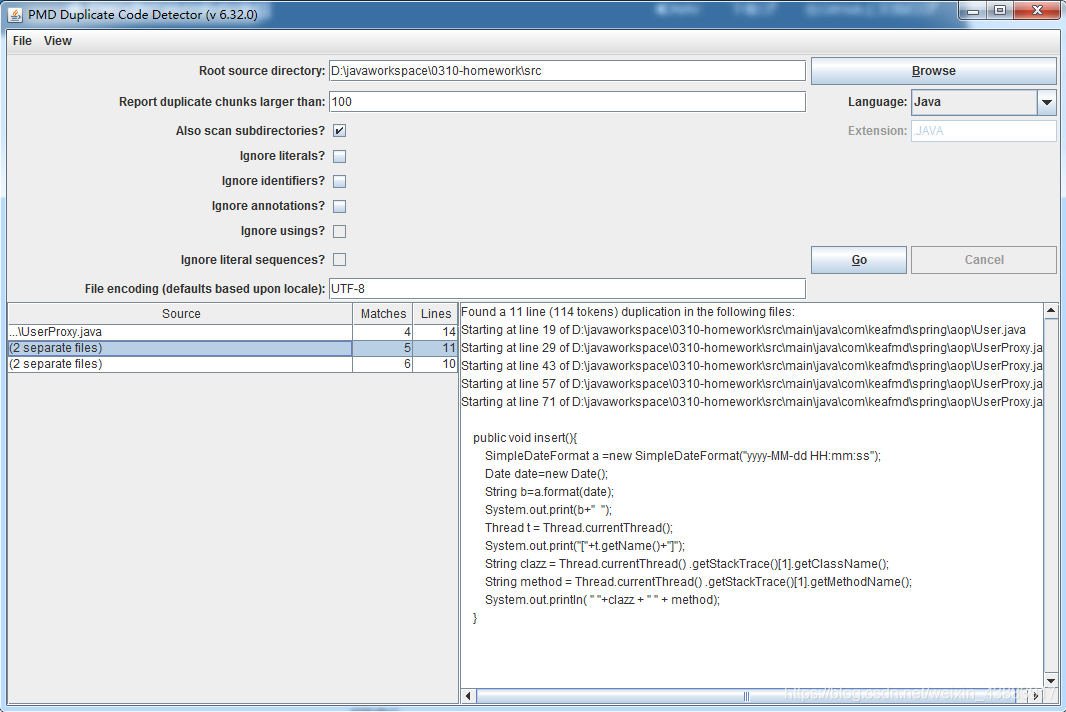
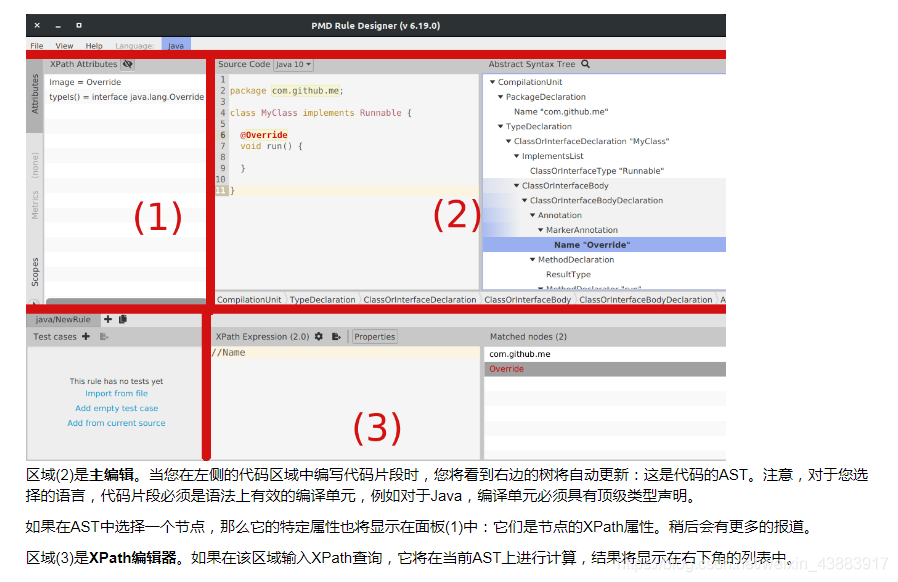
D:MyFileToolpmd-bin-6.32.0bin 目錄下打開(kāi)cmd窗口輸入:
designer.bat
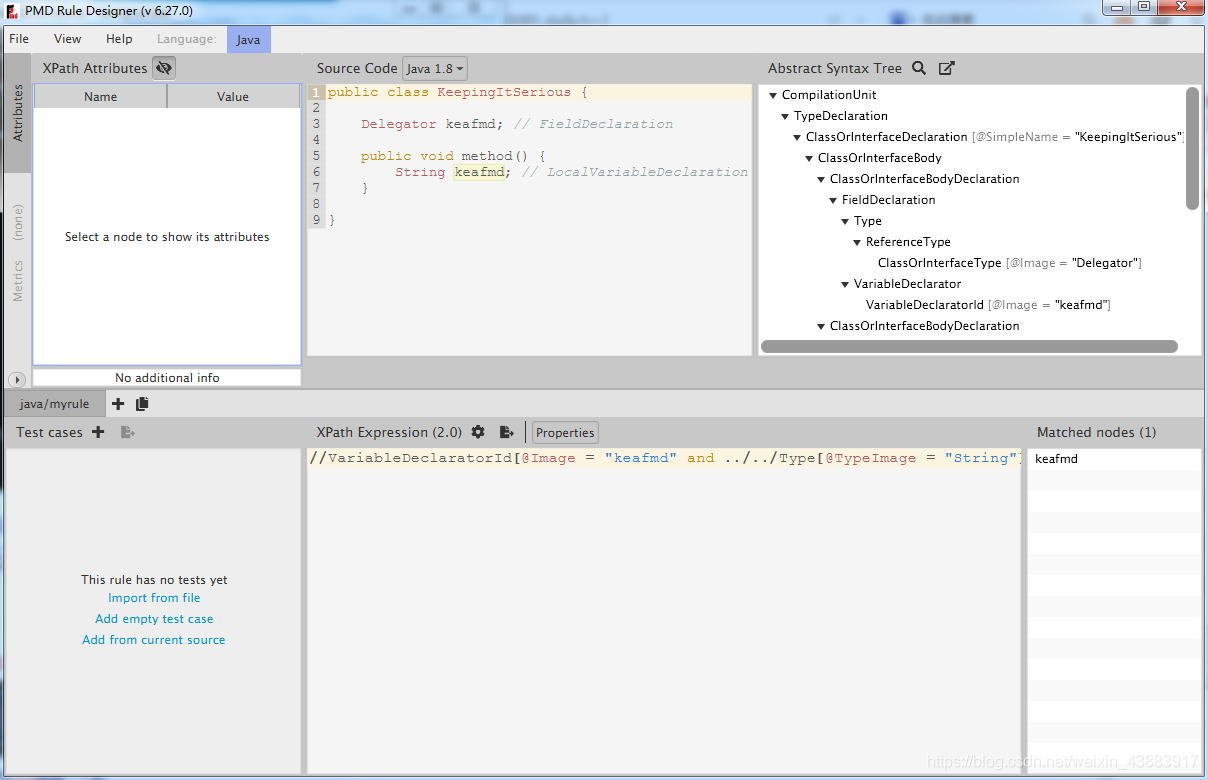
自定義規(guī)則:不能有變量為keafmd的String類(lèi)型的變量
String keafmd; //這樣就是不合法的。
Source:
public class KeepingItSerious { Delegator keafmd; // FieldDeclaration public void method() { String keafmd; // LocalVariableDeclaration }}
導(dǎo)出的自定義規(guī)則:
<rule name='myrule' language='java' message='不能有變量為keafmd的String類(lèi)型的變量' class='net.sourceforge.pmd.lang.rule.XPathRule'> <description>自定義規(guī)則 </description> <priority>3</priority> <properties> <property name='version' value='2.0'/> <property name='xpath'> <value><![CDATA[//VariableDeclaratorId[@Image = 'keafmd' and ../../Type[@TypeImage = 'String']]]]> </value> </property> </properties></rule>
到此這篇關(guān)于Java 代碼檢查工具之PMD入門(mén)使用詳細(xì)教程的文章就介紹到這了,更多相關(guān)Java 代碼檢查工具PMD內(nèi)容請(qǐng)搜索好吧啦網(wǎng)以前的文章或繼續(xù)瀏覽下面的相關(guān)文章希望大家以后多多支持好吧啦網(wǎng)!
相關(guān)文章:
1. python爬蟲(chóng)實(shí)戰(zhàn)之制作屬于自己的一個(gè)IP代理模塊2. Java程序的編碼規(guī)范(6)3. Android Studio設(shè)置顏色拾色器工具Color Picker教程4. HTML 絕對(duì)路徑與相對(duì)路徑概念詳細(xì)5. IDEA部署Docker到WSL2的詳細(xì)過(guò)程6. python實(shí)現(xiàn)PolynomialFeatures多項(xiàng)式的方法7. python實(shí)現(xiàn)在內(nèi)存中讀寫(xiě)str和二進(jìn)制數(shù)據(jù)代碼8. Spring如何使用xml創(chuàng)建bean對(duì)象9. Vue proxyTable配置多個(gè)接口地址,解決跨域的問(wèn)題10. python 利用toapi庫(kù)自動(dòng)生成api

 網(wǎng)公網(wǎng)安備
網(wǎng)公網(wǎng)安備